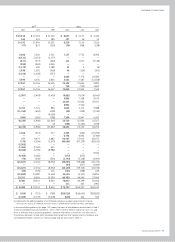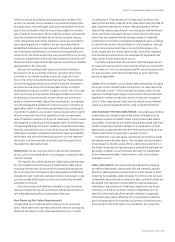GE 2011 Annual Report Download - page 79
Download and view the complete annual report
Please find page 79 of the 2011 GE annual report below. You can navigate through the pages in the report by either clicking on the pages listed below, or by using the keyword search tool below to find specific information within the annual report. GE 2011 ANNUAL REPORT 77
Sales of Goods and Services
We record all sales of goods and services only when a fi rm sales
agreement is in place, delivery has occurred or services have
been rendered and collectibility of the fi xed or determinable sales
price is reasonably assured.
Arrangements for the sale of goods and services sometimes
include multiple components. Most of our multiple component
arrangements involve the sale of goods and services in the
Healthcare segment. Our arrangements with multiple compo-
nents usually involve an upfront deliverable of large machinery
or equipment and future service deliverables such as installa-
tion, commissioning, training or the future delivery of ancillary
products. In most cases, the relative values of the undelivered
components are not signifi cant to the overall arrangement and
are typically delivered within three to six months after the core
product has been delivered. In such agreements, selling price is
determined for each component and any difference between the
total of the separate selling prices and total contract consideration
(i.e. discount) is allocated pro rata across each of the components
in the arrangement. The value assigned to each component is
objectively determined and obtained primarily from sources such
as the separate selling price for that or a similar item or from com-
petitor prices for similar items. If such evidence is not available,
we use our best estimate of selling price, which is established
consistent with the pricing strategy of the business and considers
product confi guration, geography, customer type, and other mar-
ket specifi c factors.
Except for goods sold under long-term agreements, we rec-
ognize sales of goods under the provisions of U.S. Securities and
Exchange Commission (SEC) Staff Accounting Bulletin (SAB) 104,
Revenue Recognition. We often sell consumer products and com-
puter hardware and software products with a right of return. We
use our accumulated experience to estimate and provide for such
returns when we record the sale. In situations where arrange-
ments include customer acceptance provisions based on seller
or customer-specifi ed objective criteria, we recognize revenue
when we have reliably demonstrated that all specifi ed accep-
tance criteria have been met or when formal acceptance occurs,
respectively. In arrangements where we provide goods for trial
and evaluation purposes, we only recognize revenue after cus-
tomer acceptance occurs. Unless otherwise noted, we do not
provide for anticipated losses before we record sales.
We recognize revenue on agreements for sales of goods and
services under power generation unit and uprate contracts;
nuclear fuel assemblies; larger oil drilling equipment projects;
aeroderivative unit contracts; military development contracts;
locomotive production contracts; and long-term construction
projects, using long-term construction and production contract
accounting. We estimate total long-term contract revenue net of
price concessions as well as total contract costs. For goods sold
under power generation unit and uprate contracts, nuclear fuel
assemblies, aeroderivative unit contracts, military development
contracts and locomotive production contracts, we recognize
sales as we complete major contract-specifi ed deliverables, most
often when customers receive title to the goods or accept the
services as performed. For larger oil drilling equipment projects
and long-term construction projects, we recognize sales based
on our progress towards contract completion measured by
actual costs incurred in relation to our estimate of total expected
costs. We measure long-term contract revenues by applying our
contract-specifi c estimated margin rates to incurred costs. We
routinely update our estimates of future costs for agreements in
process and report any cumulative effects of such adjustments
in current operations. We provide for any loss that we expect to
incur on these agreements when that loss is probable.
We recognize revenue upon delivery for sales of aircraft engines,
military propulsion equipment and related spare parts not sold
under long-term product services agreements. Delivery of com-
mercial engines, non-U.S. military equipment and all related spare
parts occurs on shipment; delivery of military propulsion equip-
ment sold to the U.S. Government or agencies thereof occurs upon
receipt of a Material Inspection and Receiving Report, DD Form
250 or Memorandum of Shipment. Commercial aircraft engines
are complex equipment manufactured to customer order under a
variety of sometimes complex, long-term agreements. We measure
sales of commercial aircraft engines by applying our contract-spe-
cifi c estimated margin rates to incurred costs. We routinely update
our estimates of future revenues and costs for commercial aircraft
engine agreements in process and report any cumulative effects of
such adjustments in current operations. Signifi cant components of
our revenue and cost estimates include price concessions, perfor-
mance-related guarantees as well as material, labor and overhead
costs. We measure revenue for military propulsion equipment and
spare parts not subject to long-term product services agreements
based on the specifi c contract on a specifi cally measured output
basis. We provide for any loss that we expect to incur on these
agreements when that loss is probable; consistent with industry
practice, for commercial aircraft engines, we make such provision
only if such losses are not recoverable from future highly probable
sales of spare parts for those engines.
We sell product services under long-term product main-
tenance or extended warranty agreements in our Aviation,
Transportation and Energy Infrastructure segments, where costs
of performing services are incurred on other than a straight-line
basis. We also sell product services in our Healthcare segment,
where such costs generally are expected to be on a straight-line
basis. For the Aviation, Energy and Transportation agreements,
we recognize related sales based on the extent of our progress
towards completion measured by actual costs incurred in rela-
tion to total expected costs. We routinely update our estimates
of future costs for agreements in process and report any cumu-
lative effects of such adjustments in current operations. For the
Healthcare agreements, we recognize revenues on a straight-line
basis and expense related costs as incurred. We provide for any
loss that we expect to incur on any of these agreements when
that loss is probable.
NBC Universal (NBCU), which we deconsolidated on January 28,
2011, recorded broadcast and cable television and Internet adver-
tising sales when advertisements were aired, net of provision for
any viewer shortfalls (make goods). Sales from theatrical distri-
bution of fi lms were recorded as the fi lms were exhibited; sales
of home videos, net of a return provision, when the videos were
delivered to and available for sale by retailers; fees from cable/
satellite operators when services were provided; and licensing of
fi lm and television programming when the material was available
for airing.
























